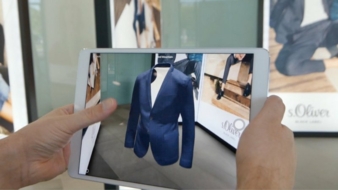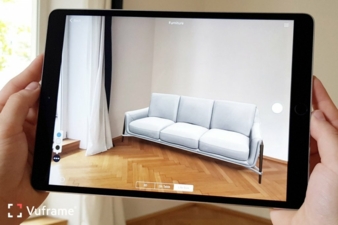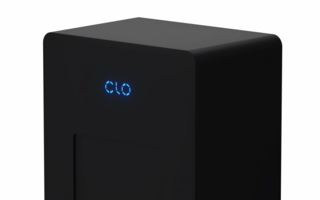13/10/2021 – Augmented Reality — auf Deutsch lesen
AR secures competitive advantages
Vuframe founder and CEO Andreas Zeitler knows the advantages of browser-based augmented reality and explains them in a short overview.
Whether it’s in design, production or fitting, 3D technology has recently found its way into the textile industry, giving many companies a head start in the digital age. For example, s.Oliver was looking for a virtual solution for their collection handover of Red Label jackets in order to save costs and resources. The fashion brand found its answer in tech company Vuframe, the German market leader for 3D product visualizations, AR and VR applications.
The result was a Red Label app and virtual showroom that allowed s.Oliver to display its new collection in photo-realistic detail from all angles in 3D, augmented and virtual reality, providing an accurate picture even before its release. Selections and buying decisions were made without spending any additional time or money on prototypes and transportation of the collection.
Vuframe founder and CEO Andreas Zeitler knows about the advantages of new technologies and has summarized the most important ones with regard to browser-based augmented reality:
1. WebAR creates a unique interactive product experience
Browser-based augmented reality (WebAR) brings a digital product into the real world of customers without the need for an app. This allows them to make informed purchasing decisions, after all, they can already see the product on themselves or within their real environment. They can “try on” the new dress at home, display the sofa in the living room to see how it fits and looks, or try out different curtains at their windows. There are no limits to configurations and colors.
2. Reduction of return rates, increase of conversions
Last year, US-based home improvement giant Home Depot announced that the use of AR in its online stores increased conversion rates and engagement significantly. Customers who can take a closer look at the product and, in the case of clothing, even see it on themselves, are less likely to return it, hence the decrease in return rates.
3. Differentiation from the competition
Before the hype come the pioneers: Online retailers among the first to transform digitally, will have a real chance of differentiating themselves from the competition by using 3D and AR technologies before everyone else is jumping on the bandwagon. With the announced Google 3D search they will have a vast advantage in terms of search rankings. The barriers for this digital transformation is relatively low: Without the need of any technical knowledge from the user, a platform solution securely and automatically converts CAD/3D data into photo-realistic 3D models compatible with any online sales channel.
4. WebAR saves resources
One opportunity is to embed 3D models of products in an existing two-dimensional online store, marketplace or social media platform to provide a one-of-a-kind shopping experience and guarantee better listings in 3D and AR friendly spaces such as Amazon or Google. Another possibility is to integrate AR capable 3D models in customizable, virtual showrooms and provide a completely virtual, gamified shopping experience while increasing dwell times. Virtual showrooms can be used for product launches, roadshows and fashion shows, without the need of physical prototypes or any costly and time-intensive logistical efforts.
5. Easy access via browser
WebAR offers hardly any entry barriers for online shoppers, no additional app or download is necessary. All customers need is an AR capable smartphone or tablet for them to be able to switch from shop view to AR view with just one click and the help of their camera. At the same time, the use of mobile devices in online shopping– especially smartphones– is increasing every year. Desktop shopping is moving further and further into the background. Browser-based AR benefits online retailers because they don’t need to invest in further applications and are able to reach a broader audience.



